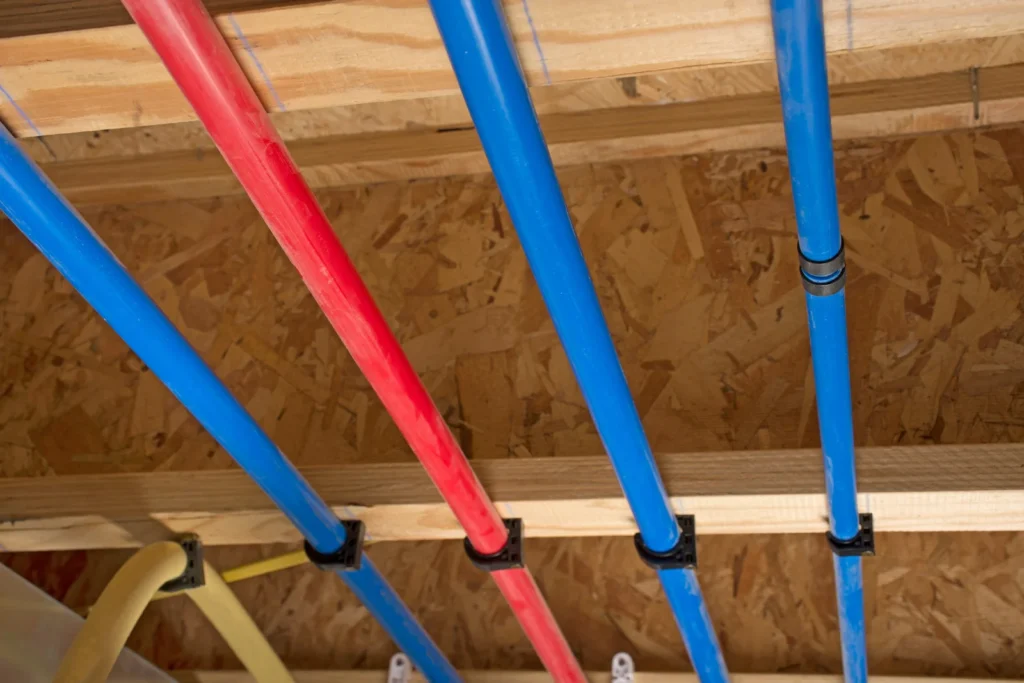
Homes all across America have many different types of pipes, and one of the most common types are called PEX pipes. PEX pipes are flexible plastic pipes commonly used in plumbing systems. PEX pipes are popular due to their durability, resistance to freezing, and ease of installation. PEX pipes come with a number of benefits, including flexibility, corrosion resistance (unlike metal/copper pipes), ease of installation, and general cost-effectiveness.
Despite all the benefits, PEX pipes can still freeze during those cold winter season temperatures that we often experience in the Ohio region. While these pipes are more resistant to freezing and bursting than metal pipes, it’s still possible for PEX to burst if frozen repeatedly or exposed to extreme weather conditions.
Can PEX Pipes Freeze?
PEX pipes can freeze but are much more resistant to freezing and bursting than traditional metal pipes like copper or steel. The flexibility of PEX allows it to expand when the water inside freezes and then contract back to its original size when water thaws.
While PEX is more freeze-resistant, it’s not entirely immune to damage. PEX pipes, like other water-filled pipes, can begin to freeze at 32 degrees Fahrenheit. Repeated freeze-thaw cycles or extreme cold temperatures can still cause problems. Insulating PEX pipes in areas prone to cold temperatures, like attics or crawl spaces, is recommended to avoid freezing.
Why Are PEX Pipes Less Likely to Burst?
PEX pipes are less likely to burst when frozen due to their material design features:
- Flexibility and Elasticity
- The flexible material allows pipes to expand when water inside them freezes.
- Expansion and Contraction
- PEX can expand up to three times its original diameter without breaking, reducing the likelihood of bursting.
- Fewer Joints and Fittings
- PEX is often installed with fewer fittings and joints because it can be maneuvered around obstacles.
- Resilience Against Stress
- Repeated expansion and contraction over time are less likely to weaken the pipe.
- Non-Corrosive Material
- PEX pipes don’t corrode like metal pipes.
- Resistance to Scale and Deposits
- PEX is resistant to scaling and mineral deposits.
How Do I Identify Frozen PEX Pipes?
To determine if your PEX pipes are at risk of freezing, carefully consider the following factors:
Location of the pipes
Pipes in unheated or poorly insulated areas are more vulnerable to freezing.
Insulation Quality
Check for insulation on exposed PEX pipes and around pipe entry points in exterior walls.
Temperature Drops
If outdoor temperatures are expected to drop below 32 degrees Fahrenheit, your pipes could be at risk.
Inconsistent Heating in Your Home
Ensuring consistent heating throughout the house reduces the risk of freezing pipes.
Lack of Water Flow
Stagnant water is more likely to freeze than moving water. Allowing faucets to drip slightly can help prevent freezing.
Drafts and Air Leaks
Check for drafts near pipe entry pipes. Cold air leaking in from outside can increase the risk of freezing.
History of Frozen Pipes
If you’ve experienced frozen pipes in the past, those areas are likely to be at risk again. Addressing these vulnerable points is absolutely critical.
Immediate Steps to Take When PEX Pipes Freeze
If your PEX pipes freeze, acting quickly to prevent them from bursting is essential. Here are the immediate steps you should take:
- Shut Off the Water Supply
- Locate the main water shut-off valve and turn it off. This will prevent water from rushing out and causing a flood if the pipe bursts once it thaws.
- Open Affected Faucets
- Open the faucets that are supplied by the frozen pipe. This helps relieve pressure and allows water to flow as the ice melts.
- Locate the Frozen Section
- Inspect the pipe along its length, especially in areas prone to freezing. Look for frosty areas, bulging pipes, or spots that feel much colder than others.
- Gradually Apply Heat
- Use a safe heat source like a hairdryer, space heater, or heat tape to warm the frozen section of the pipe slowly. Start from the faucet end and work back toward the frozen area to allow the ice to melt and the water to flow out. DO NOT USE: Any high-heat source that could damage the PEX or cause a fire.
- Monitor for Leaks
- As the ice melts, monitor the pipe for any leaks or cracks. Even though PEX is more resistant to bursting, damage may still occur. If you notice any leaks, keep the water supply off until the pipe can be repaired.
- Restore Water Flow Slowly
- Once the pipe is thawed and you’ve checked for damage, slowly turn the water supply back on while keeping an eye on the pipe and faucets for leaks.
- Call a Plumbing Professional
- If you cannot locate the frozen section, safely thaw the pipe, or if there is significant damage, call one of our professional plumbers immediately. Our expert plumbers are happy to help you and will find a solution for your frozen pipes.
Preventative Measures to Avoid Freezing PEX Pipes
Preventative measures you can take to avoid freezing PEX pipes are:
- Insulate any exposed pipes in cold areas.
- Seal gaps and cracks where cold air can enter.
- Keep consistent temperatures in the home, even if it’s slightly warmer than usual.
- Open cabinet doors sinks to allow warm air to circulate around pipes.
- In extreme cold, let faucets drip to keep water moving.
Being proactive about these risk factors can help prevent your PEX pipes from freezing during cold winter days.
Frequently Asked Questions About Frozen PEX Pipes
What temperature do PEX pipes freeze at?
PEX pipes, like all water-filled pipes, can freeze when temperatures drop below 32 degrees Fahrenheit.
Can PEX pipes burst if they freeze repeatedly?
PEX pipes can burst if they freeze repeatedly. Although they are designed to expand when water freezes, repeated freeze-thaw cycles can weaken the pipe over time.
How do I know if my PEX pipes are at risk of freezing?
Consider the following factors when determining if your PEX pipes are at risk of freezing:
- Location of the Pipes – Pipes in unheated or poorly insulated areas are at higher risk. If your PEX pipes run through these areas, they are more vulnerable to freezing.
- Insulation Quality – Check for insulation on exposed PEX pipes and around pipe entry points in exterior walls.
- Temperature Drops – Pay attention to weather forecasts. If outdoor temperatures are expected to drop below 32 degrees Fahrenheit for an extended period, your pipes could be at risk.
- Inconsistent Heating in the Home – If some parts of your home are kept at lower temperatures, the pipes in those colder zones could freeze.
- Lack of Water Flow – Stagnant water is more likely to freeze than moving water. Allow faucets to drip if you will be away during colder weather.
- Drafts and Air Leaks – Check for drafts near pipe entry points; cold air leaking from outside can increase the risk of freezing.
- History of Frozen Pipes – If you’ve experienced frozen pipes in the past, those areas are more likely to be at risk again, even with PEX. Identifying and addressing these vulnerable is crucial.
If you have PEX pipes in your home, follow the preventative measures we discussed above: insulate pipes, seal gaps, keep consistent temperatures, open cabinet doors, and allow faucets to drip slightly. Looking at your pipes and ensuring any issues are taken care of can help in the long run. You don’t want to wait until it’s too late. Winter may be months away, but you can save money on costly repairs if you take preventative steps now. Logan Services has experts to help find solutions for any plumbing issues you may be experiencing. Our knowledgeable team can walk you through your options and ensure you stay comfortable in your home.




















